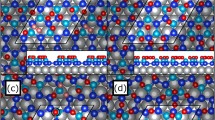Abstract
The structure and stability of a two-layer defective silicene on Ag(001) and Ag(111) substrates have been investigated using the molecular dynamics method. The transformation of the radial distribution function of silicene due to the formation of monovacancies, divacancies, trivacancies, and hexavacancies is reduced primarily to a decrease in the intensity of the peaks and the disappearance of the “shoulder” in the second peak. With the passage of time, multivacancies can undergo coalescence with each other and the fragmentation into smaller vacancies, as well as form vacancy clusters. According to the geometric criterion, the Ag(001) substrate provides a higher stability of a perfect two-layer silicene. It has been found, however, that the defective silicene on this substrate has a lower energy only when it contains monovacancies and divacancies. A change in the size of defects leads to a change in the energy priority when choosing between the Ag(001) and Ag(111) substrates. The motion of a lithium ion inside an extended channel between two silicene sheets results in a further disordering of the defective structure of the silicene, during which the strongest stresses in the silicene are generated by forces directed perpendicular to the external electric field. These forces dominate in the silicene channel, the wall of which is supported by the Ag(001) or Ag(111) substrate.
Similar content being viewed by others
References
P. Vogt, P. de Padova, C. Quaresima, J. Avila, E. Frantzeskakis, M. C. Asensio, A. Resta, B. Ealet, and G. le Lay, Phys. Rev. Lett. 108, 155501 (2012).
B. J. Feng, Z. Ding, Sh. Meng, Y. Yao, X. He, P. Cheng, L. Chen, and K. Wu, Nano Lett. 12, 3507 (2012).
A. Fleurence, R. Friedlein, T. Ozaki, H. Kawai, Y. Wang, and Y. Yamada-Takamura, Phys. Rev. Lett. 108, 245501 (2012).
L. Meng, Y. Wang, L. Zhang, Sh. Du, R. Wu, L. Li, Y. Zhang, G. Li, H. Zhou, W. A. Hofer, and H.-J. Gao, Nano Lett. 13, 685 (2013).
M. R. Tchalala, H. Enriquez, A. J. Mayne, A. Kara, S. Roth, M. G. Silly, A. Bendounan, F. Sirotti, T. Greber, B. Aufray, G. Dujardin, M. A. Ali, and H. Oughaddou, Appl. Phys. Lett. 102, 083107 (2013).
G. le Lay, B. Aufray, C. Léandri, H. Oughaddou, J.-P. Biberian, P. de Padova, M. E. Dávila, B. Ealet, and A. Kara, Appl. Surf. Sci. 256, 524 (2009).
F. Banhart, J. Kotakoski, and A. V. Krasheninnikov, ACS Nano 5, 26 (2011).
A. E. Galashev, Tech. Phys. 59 (4), 467 (2014).
J. F. Gao, J. F. Zhang, H. S. Liu, Q. Zhang, and J. Zhao, Nanoscale 5, 9785 (2013).
V. O. Özçelik, H. H. Gurel, and S. Ciraci, Phys. Rev. B: Condens. Matter 88 (4), 045440 (2013).
A. E. Galashev and O. R. Rakhmanova, Phys.—Usp. 57 (10), 970 (2014).
W. Hu, X. Wu, Z. Li, and J. Yang, Nanoscale 5, 9062 (2013).
A. Ambrosetti and P. L. Silvestrelli, J. Phys. Chem. C 118, 19172 (2014).
G. R. Berdiyorov and F. M. Peeters, RSC Adv. 4, 1133 (2014).
H. Jamgotchian, Y. Colignon, B. Ealet, B. Parditka, J.-Y. Hoarau, C. Girardeaux, B. Aufray, and J.-P. Bibérian, J. Phys.: Conf. Ser. 491, 012001 (2014).
S. Li, Y. Wu, Y. Tu, Y. Wang, T. Jiang, W. Liu, and Y. Zhao, Sci. Rep. 5, 7881 (2015).
T. H. Osborn and A. A. Farajian, J. Phys. Chem. C 116, 22916 (2012).
J. Tersoff, Phys. Rev. B: Condens. Matter 49, 16349 (1994).
A. E. Galashev, O. R. Rakhmanova, and Yu. P. Zaikov, Phys. Solid State 58 (9), 1850 (2016).
R. Yu, P. Zhai, G. Li, and L. Liu, J. Electron. Mater. 41, 1465 (2012).
K.-N. Chiang, C.-Y. Chou, C.-J. Wu, C.-J. Huang, and M.-C. Yew, in Proceedings of the International Conference on Computer Engineering and Systems (ICCES 2009), Cairo, Egypt, December 14–16, 2009, p 130.
S. K. Das, D. Roy, and S. J. Sengupta, J. Phys. F: Met. Phys. 7, 5 (1977).
J. R. Bordin, Phys. A (Amsterdam, Neth.) 459, 1 (2016).
K. Kawahara, T. Shirasawa, R. Arafune, C.-L. Lin, T. Takahashi, M. Kawai, and N. Takagi, Surf. Sci. 623, 25 (2014).
R. Wang, S. Wang, and X. Wu, arXiv:1305.4789v2 [cond-mat.meshall] 23 May 2013. http://www.researchgate.net/publication/236871722.
B. Peng, F. Cheng, and Z. Tao, J. Chen. Chem. Phys. 133, 034701 (2010).
K. Müller, F. F. Krause, A. Béché, M. Schowalter, V. Galioit, S. Löffler, J. Verbeeck, J. Zweck, P. Schattschneider, and A. Rosenauer, Nat. Commun. 5, 5653 (2014).
A. E. Galashev and V. A. Polukhin, Phys. Met. Metallogr. 115 (7), 697 (2014).
A. E. Galashev, Phys. Met. Metallogr. 117 (3), 238 (2016).
S. J. Plimpton, Comput. Phys. 117, 1 (1995).
M. R. Chavez-Castillo, M. A. Rodriguez-Meza, and L. Meza-Montes, Rev. Mex. Fis. 58, 139 (2012).
F. H. Stillinger and T. A. Weber, Phys. Rev. B: Condens. Matter. 31, 5262 (1985).
G. L. Lay, www.uv.es/wsetld/archivos/Monday/ws10-Le-Lay.pdf.
A. E. Galashev and V. A. Polukhin, Russ. J. Phys. Chem. A 88 (6), 995 (2014).
A. E. Galashev and V. A. Polukhin, Phys. Solid State 55 (8), 1733 (2013).
A. E. Galashev and A. A. Galasheva, High Energy Chem. 48 (2), 112 (2014).
A. E. Galashev, I. A. Izmodenov, A. N. Novruzov, and O. A. Novruzova, Semiconductors 41 (2), 190 (2007).
A. E. Galashev, V. A. Polukhin, I. A. Izmodenov, and O. R. Rakhmanova, Glass Phys. Chem. 32 (1), 99 (2006).
M. A. Ledina, X. Liang, Y. G. Kim, J. Jung, B. Perdue, C. Tsang, M. P. Soriaga, and J. L. Stickney, ECS Trans. 66 (6) 129 (2015).
T. P. Kaloni, M. Tahir, and U. Schwingenschlögl, Sci. Rep. 3, 3192 (2013).
Author information
Authors and Affiliations
Corresponding author
Additional information
Original Russian Text © A.E. Galashev, K.A. Ivanichkina, A.S. Vorob’ev, O.R. Rakhmanova, 2017, published in Fizika Tverdogo Tela, 2017, Vol. 59, No. 6, pp. 1218–1227.
Rights and permissions
About this article
Cite this article
Galashev, A.E., Ivanichkina, K.A., Vorob’ev, A.S. et al. Structure and stability of defective silicene on Ag(001) and Ag(111) substrates: A computer experiment. Phys. Solid State 59, 1242–1252 (2017). https://doi.org/10.1134/S1063783417060087
Received:
Accepted:
Published:
Issue Date:
DOI: https://doi.org/10.1134/S1063783417060087




